Building an integrated SPEAR T-cell company January 2018 1
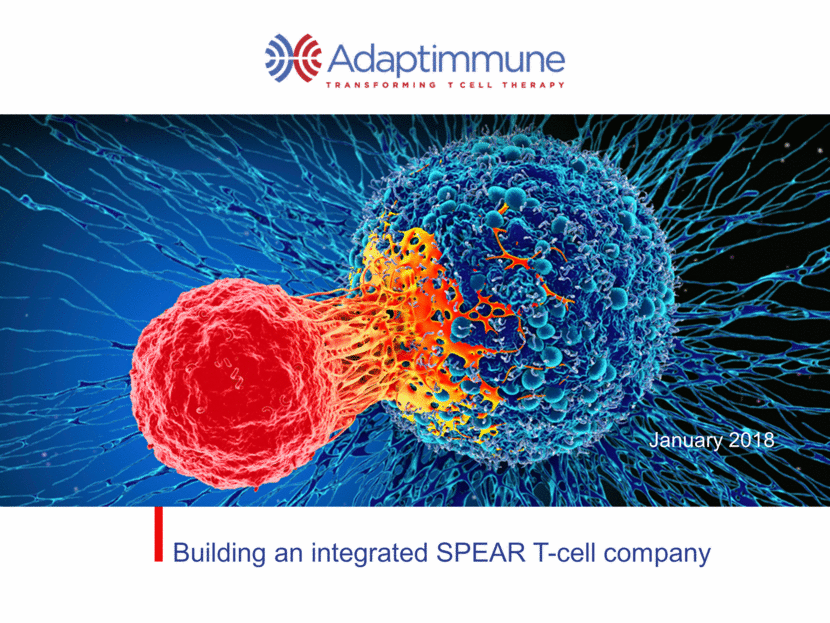
Disclaimer 2 This presentation contains “forward-looking statements,” as that term is defined under the Private Securities Litigation Reform Act of 1995 (PSLRA), which statements may be identified by words such as “believe,” “may,” “will,” “estimate,” “continue,” “anticipate,” “intend,” “expect” and other words of similar meaning. These forward-looking statements involve certain risks and uncertainties. Such risks and uncertainties could cause our actual results to differ materially from those indicated by such forward-looking statements, and include, without limitation: the success, cost and timing of our product development activities and clinical trials; our ability to submit an IND and successfully advance our technology platform to improve the safety and effectiveness of our existing TCR therapeutic candidates; the rate and degree of market acceptance of T-cell therapy generally and of our TCR therapeutic candidates; government regulation and approval, including, but not limited to, the expected regulatory approval timelines for TCR therapeutic candidates; and our ability to protect our proprietary technology and enforce our intellectual property rights; amongst others. For a further description of the risks and uncertainties that could cause our actual results to differ materially from those expressed in these forward-looking statements, as well as risks relating to our business in general, we refer you to our Quarterly Report on Form 10-Q filed with the Securities and Exchange Commission (SEC) on November 2, 2017 and our other SEC filings. We urge you to consider these factors carefully in evaluating the forward-looking statements herein and you are cautioned not to place undue reliance on such forward-looking statements, which are qualified in their entirety by this cautionary statement. The forward-looking statements contained in this presentation speak only as of the date the statements were made and we do not undertake any obligation to update such forward-looking statements to reflect subsequent events or circumstances. We intend that all forward-looking statements be subject to the safe-harbor provisions of the PSLRA.

Our proprietary SPEAR T-cell platform 3 TCR T-cell therapy for cancer patients Specific Peptide Enhanced Affinity Receptor
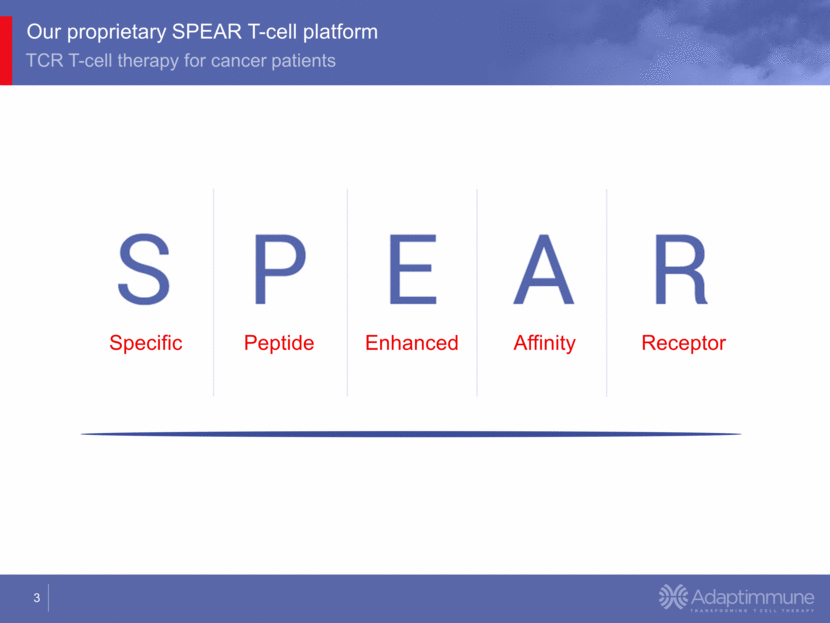
4 Leaders in TCR T-cell therapy Proprietary pipeline in solid tumors with data through 2018 Strong data from partnered NY-ESO program in 2017 Scientific leadership in TCR T-cell therapy Building a fully integrated cell therapy company Solid financial position Data in 2018 from proprietary pipeline in solid tumors

Data in 2018 from proprietary pipeline in solid tumors

MAGE-A10 MAGE-A4 AFP Urothelial Melanoma Head & Neck NSCLC (lung) Urothelial Melanoma Head & Neck Ovarian NSCLC (lung) Esophageal Gastric Hepatocellular PROGRAM INDICATIONS PRE-CLINICAL PHASE I / II REGISTRATION ADDITIONAL SPEAR T-CELL CANDIDATES Our proprietary pipeline 6 Multiple targets/Multiple indications
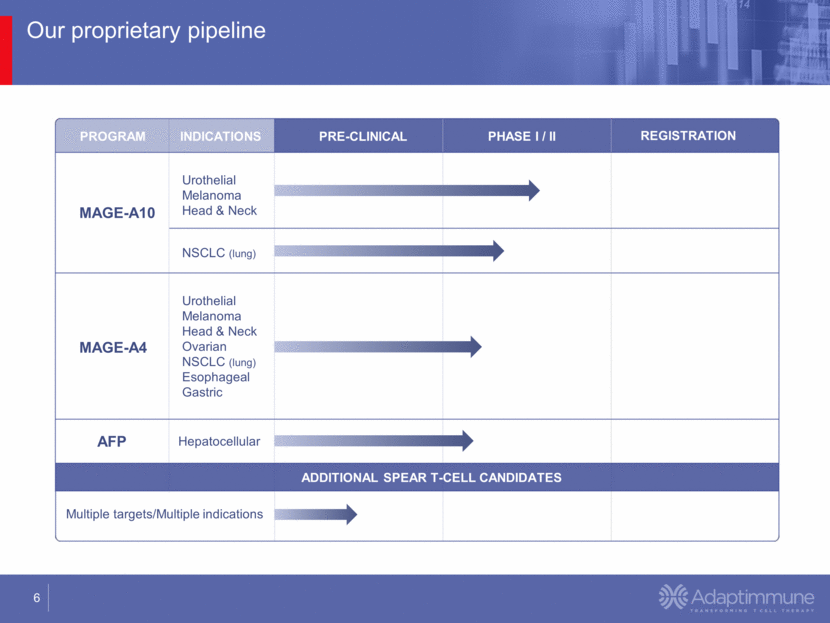
MAGE-A10 update from triple tumor and NSCLC (lung) studies 7 Dose escalation studies – first data from 8 patients dosed * NSCLC Group 1a Cy only (1800mg/m2 X 2 days); all other patients (Cy [600mg/m2/day] + Flu [30mg/m2/day]) X 3 days NOTE: No deaths attributable to SPEAR T-cell therapy Data cut-off Dec. 2017 Triple tumor Cohort 1 (3 dosed) Cohort 2 dosing approved at 1 billion cells SPEAR T-cells detectable in blood off-target toxicity No evidence of NSCLC dosing in 1a* 1 DLT (CRS) Expanded to 6 pts 5 dosed
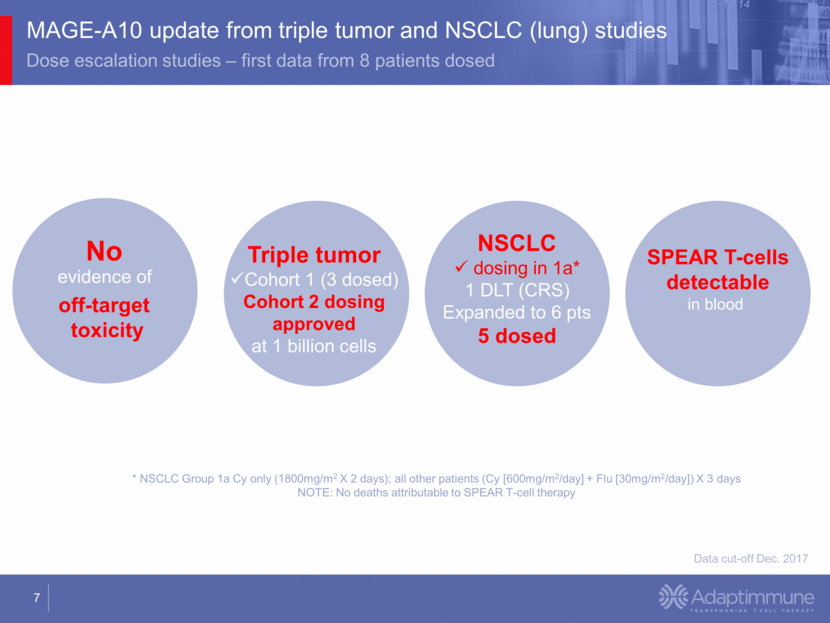
SPEAR T-cells associated with low incidence of severe toxicity 8 Data from all 88 patients, treated with MAGE-A10 or NY-ESO, to date ~7% CRS Grade 3 or above* no grade 5 *Proportion of patients with grade > 3 CRS/total dosed across TCRs = 6/88 = 6.8% (All cases resolved) **CRES = CAR-T related encephalopathy; Nat Rev Clin Oncol. 2017 Sep 19. Data cut-off Dec. 2017 of seizure, cerebral edema, or CRES-like events** No reports

9 MAGE-A10 response data MAGE-A4 response data AFP safety data H2 2018 Pivotal trials New candidates 2nd generation trials Universal Cells collaboration Manufacturing expansion Beyond 2018 MAGE-A4 Safety review for dose escalation Q2 2018 2018 is a critical year to deliver clinical data from our proprietary pipeline Our pipeline in multiple solid tumors MAGE-A10 Triple tumor safety review and move to next dose MAGE-A10 NSCLC safety review for dose escalation Q1 2018
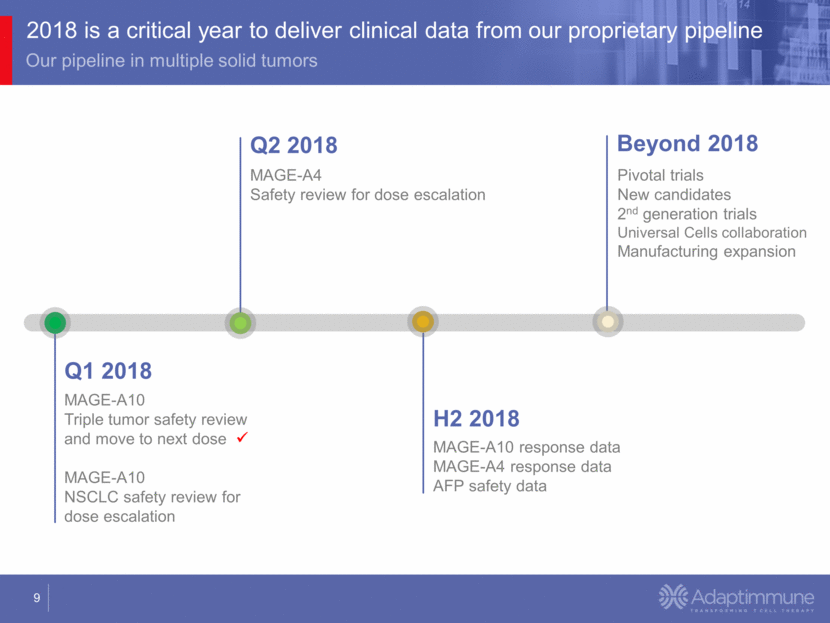
Strong data for partnered NY-ESO program in 2017

Enrollment for NY-ESO clinical trials 11 Being transitioned to GSK as part of the option agreement *Adaptimmune’s accrual complete **Ongoing MRCLS = myxoid/round cell liposarcoma PROGRAM INDICATIONS PRE-CLINICAL PHASE I / II REGISTRATION NY-ESO NY-ESO + Keytruda Synovial sarcoma* MRCLS* NSCLC (lung) * Multiple myeloma**
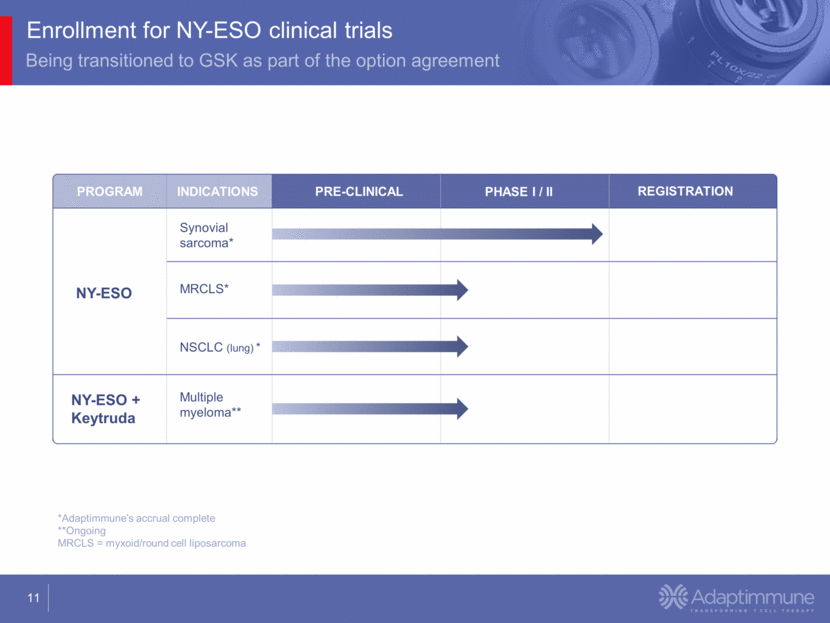
Robust data in a “cold” solid tumor 12 NY-ESO in synovial sarcoma (CTOS / ASCO 2017); program partnered with GSK SPEAR T-cell expansion correlates with efficacy All cohorts confirmed CTOS Data cut-off 5 Sep 2017 3+ *At target dose for Cohort 1 (n=10; ASCO 2017); for all 12 Cohort 1 patients median OS is ~120 wks (2+ yrs; CTOS 2017) responses Cohorts 1 (50%); 2 (33%); 3 (20%); 4 (36%) years median predicted overall survival* Baseline (cohort 4) - 34 yr old female; synovial sarcoma lung - Prior therapies doxorubicin, ifosfamide, pazopanib, gemcitabine, 7 surgical resections - Target lesion per RECIST(v1.1) 54mm Week 4 - Had received 2.8 x 109 transduced T-cells - Partial response at 4 weeks - 77% decrease in tumor burden Week 8 - Partial response maintained - Lesion completely resolved by next assessment
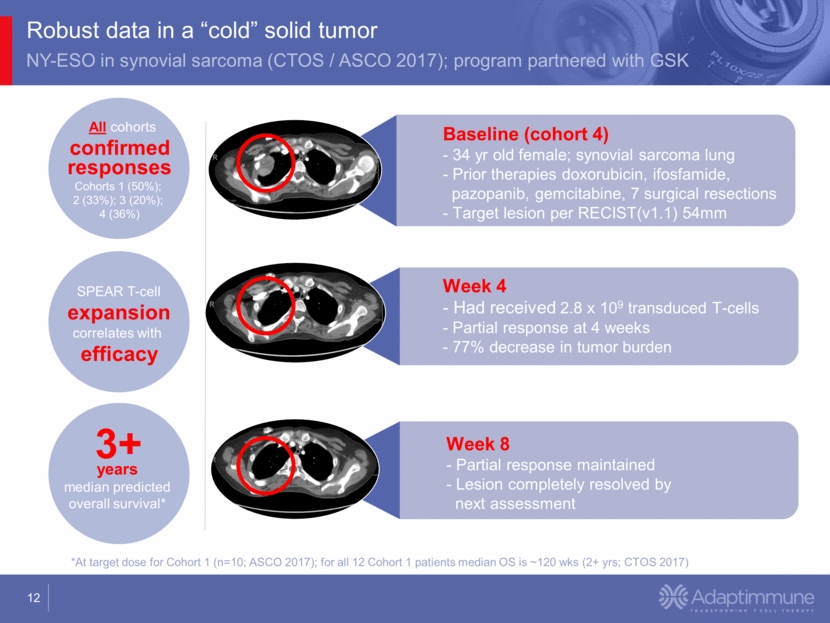
SPEAR T-cells lead to T-cell infiltration in “checkpoint resistant” tumors 13 SPEAR T-cells can overcome mechanisms that prevent tumor inflammation Pre-SPEAR T-cells Week 8 post-infusion CD3 (pan T-cell marker) CD8 (cytotoxic T-cell marker)
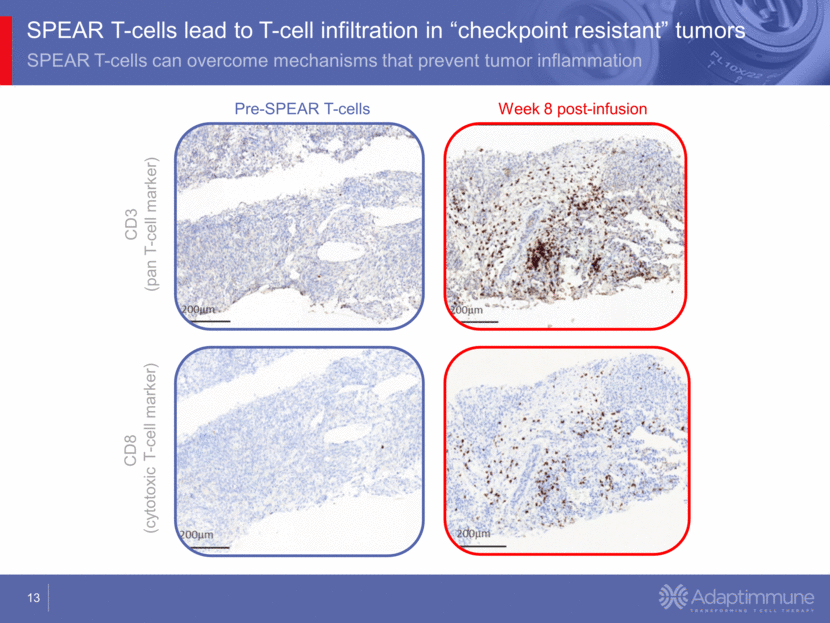
Building a fully integrated cell therapy company

Strong momentum towards our ambition 15 Becoming a fully integrated cell therapy company Target validation Target identification TCR engineering Pre-clinical testing Clinical testing Vector manufacturing SPEAR T-cell manufacturing HCAT (PCT) Navy Yard Regulatory Commercial In progress CMO network Additional sources
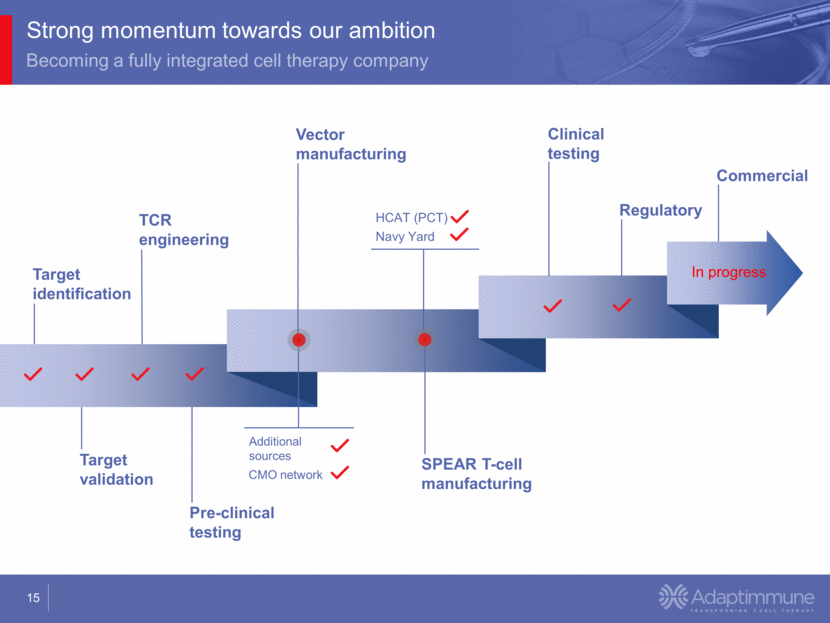
Manufacturing and vector supply update 16 Secure cell and vector manufacturing Cell manufacturing in-house and at CMO Adaptimmune’s facility now operational with successful product manufactured for a MAGE-A4 patient Enables more rapid process improvement and patient scheduling flexibility Capacity for ~300 patients per year that can expand to ~1000 Continued CMO space at HCAT (formerly PCT) Vector supply through 2019 and beyond CMO vector inventory on hand / booked for all pilot programs Agreement for dedicated vector manufacturing capability (2018) Space secured for in-house vector manufacturing Relationships with multiple CMOs for additional vector supply

17 The patient’s cell journey Bringing the manufacturing process in-house MANUFACTURING PATIENT PATIENT Apheresis / Cell collection Freeze Positive selection of T-cells (CD3/CD28 Dynabeads) Expansion of T-cells (CD3/CD28 Dynabeads) Lentiviral gene transfer of engineered TCR Harvest & freeze SPEAR T-cells SPEAR T-cell infusion Release testing Ship to manufacturing site Lymphodepletion Ship
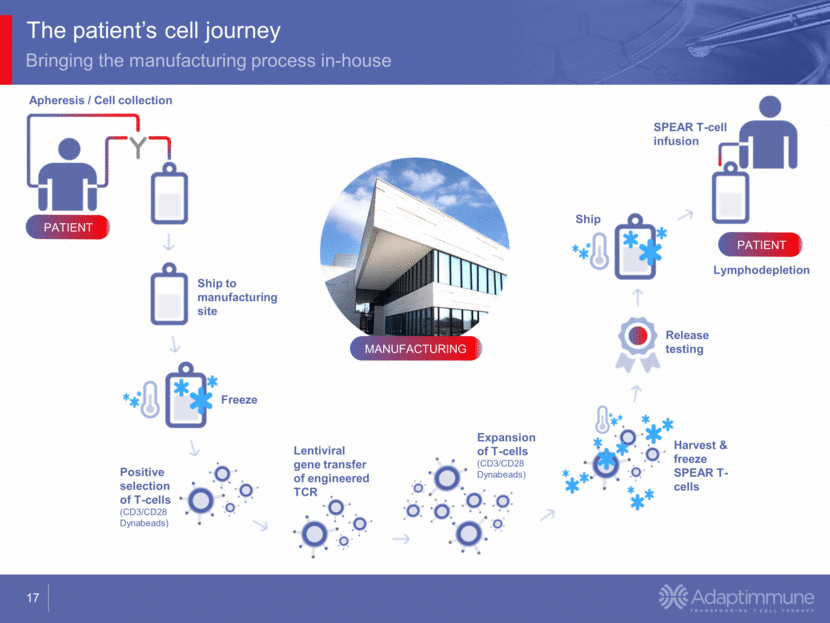
18 MANUFACTURING Target and peptide validation Preconditioning regimen requires fludaribine; IL-2 not required Need for 1B transduced cells Responses observed with low antigen expression Neurotoxicity and CRS different from other T-cell therapies T-cells penetrate tumor and persist for years Translational science informing next generation approaches In progress Expertise in identifying mechanisms of resistance Freeze cells upfront and at the end Navy Yard manufacturing up and running Fully closing the process In progress Reduce duration of release testing In progress Vein-to-vein chain of custody In progress US and EU logistics In progress PATIENT RECRUITMENT Strategic alliance with MD Anderson Cancer Center Training teams in leading cancer centers Central HLA and antigen testing, separate screening protocol Key learnings Adaptimmune is leading the TCR T-cell therapy field R&D & CLINICAL TRIALS
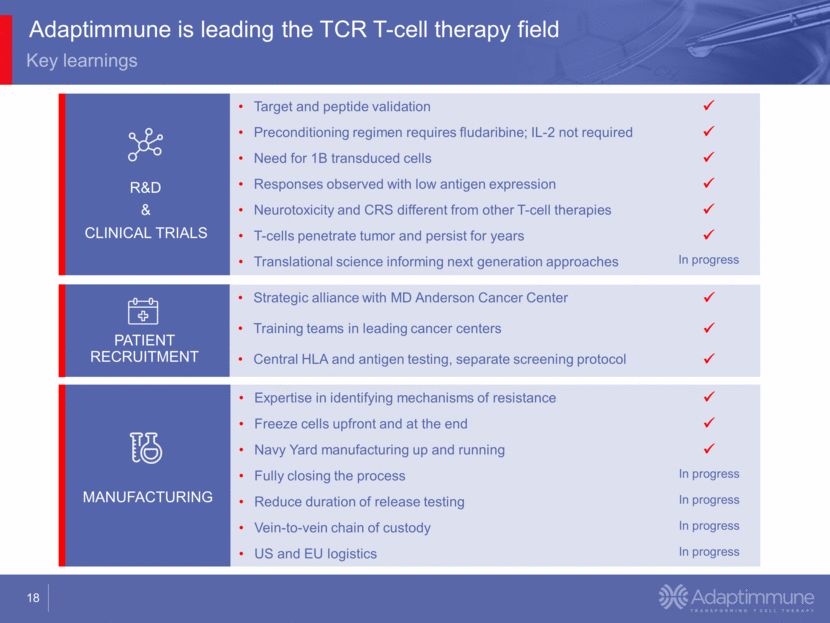
Scientific leadership in TCR T-cell therapy
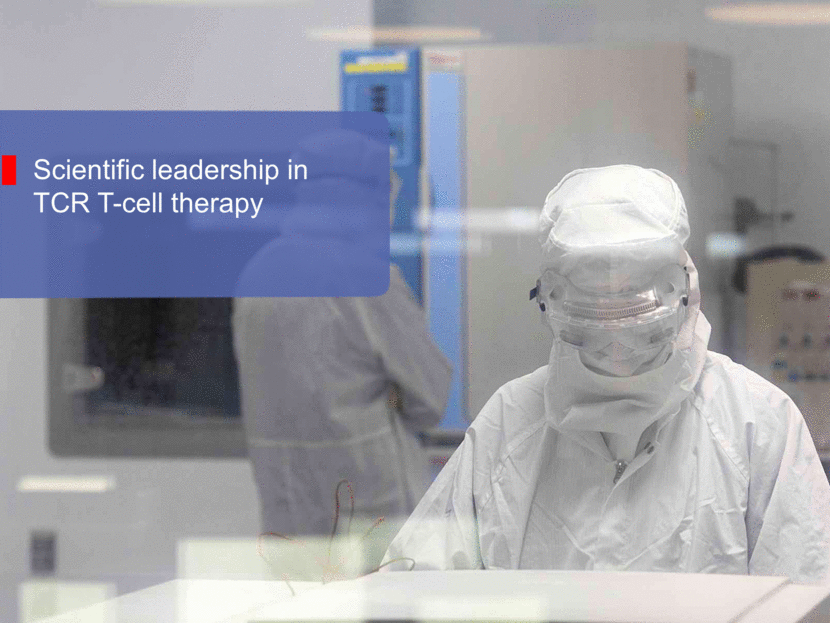
SPEAR T-cells target solid tumors 20 T-cell therapy in the context of immunotherapy Antibody-based approach to cell surface antigens For the majority of approaches, access to extracellular proteins only TCR-based recognition More options for targeting cancers by enhancing the body’s natural immune system: • T-cells scan HLA-peptides with TCRs • Access to entire spectrum of extra- and intra-cellular proteins • TCR is T-cell’s native receptor • Ability to address solid tumors Cancer cell SPEAR T-cell Cancer cell T-cell HLA-peptide antigen T-cell receptor Cancer cell CAR-T cell Other approaches CAR-NK-cells ADC Bispecific Ab TCR mimic Ab gd T-cells NK-cells TILs ImmTAC

How Adaptimmune gets TCRs and targets right 21 Securing our future pipeline Target identification Generate TCRs for any target Mass spec validation of processed peptides in HLA Confirmation of protein expression Dedicated target validation program Molecular database screens and literature Mass spec. >1.2 million peptides in our database Multiple methods for TCR identification / generation Optimal specificity Lack of alloreactivity Proprietary technology to affinity optimize SPEAR T-cells Overcomes naturally occurring low TCR affinities Can target solid tumors SPEAR T-cells functional as both CD4 or CD8 T-cells, which significantly increases potency

22 The target and the TCR are key to avoid on target and off target toxicity How targets and TCRs may be wrong Wrong peptide or peptide not expressed in desired HLA Target found on healthy cells A different target cross reactive with the TCR is found on healthy cells Mass spectrometry – over 1.2 million peptides in our database Expression profile in normal and tumor tissue confirmed by molecular arrays, tissue arrays, and proteomics Molecular profiling establishes binding motif recognized by each TCR – only those specific for peptide selected Alloreactivity – reacting to another HLA (target independent issue) Alloreactivity panel of multiple HLAs for screening of candidate TCRs How we identify the right targets and TCRs
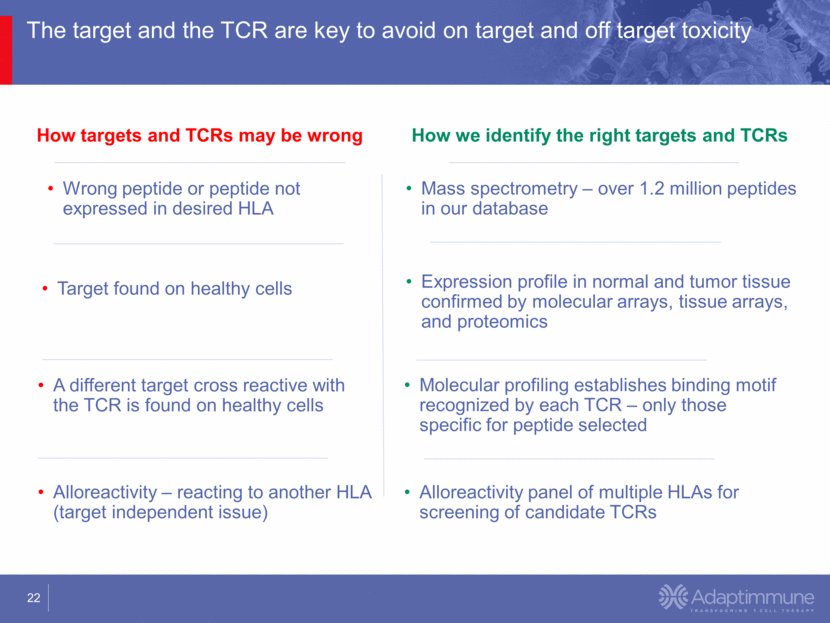
No affinity Low affinity High affinity TCR does not bind antigen TCR binds with low affinity Only low affinity TCR T-cells mature TCR binds antigen too strongly Thymocyte dies (death by neglect) Thymocyte matures (positive selection) Thymocyte dies (negative selection) Why SPEAR T-cell affinity enhancement is necessary 23 Naturally occurring tumor reactive T-cells are low affinity due to thymic selection All peptides are presented in the thymus thymic epithelial cell
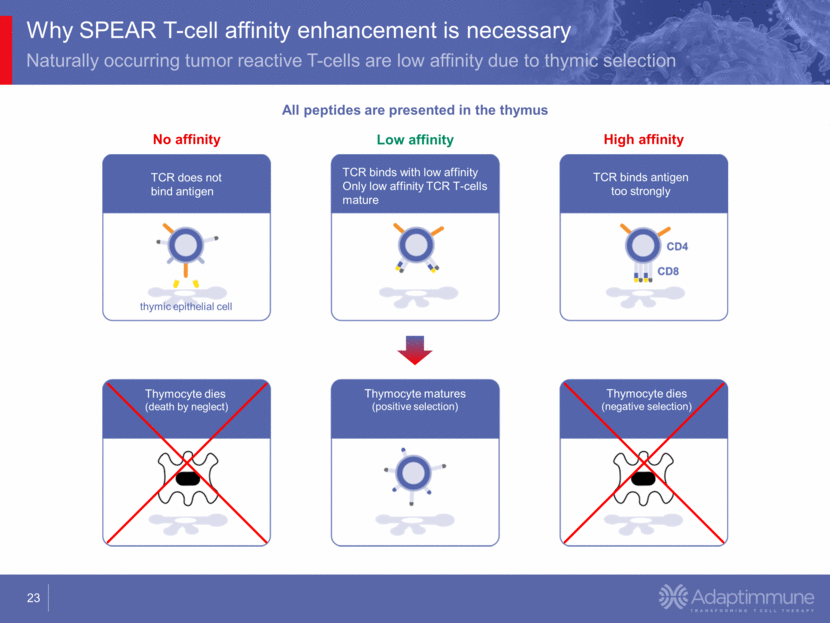
TCR binds the target in correct HLA? Representative ELISPOT data from cells displaying antigen target (AFP+) in correct HLA context (A2+) Adaptimmune makes SPEAR T-cells with the right affinity 24 Affinity No TCR Natural affinity Enhanced affinity TCR candidates No reactivity Cross reactivity Potency Is TCR cross-reactive? Representative ELISPOT data from cells displaying antigen target (AFP+) in incorrect HLA (A2neg); or without target (AFPneg) in correct HLA (A2+) Testing a panel of engineered TCR candidates
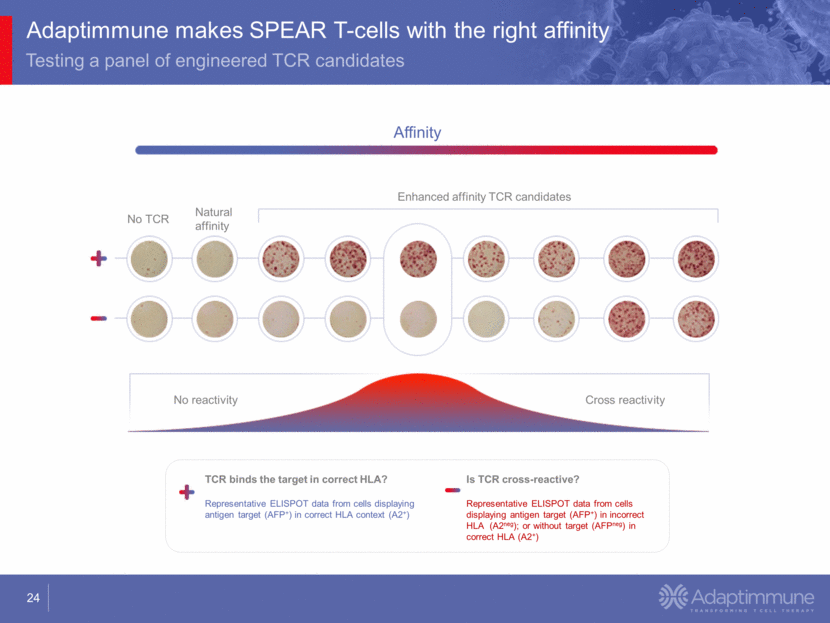
Building a strategic portfolio of next generation SPEAR T-cells 25 Staying ahead of the tumor Overcoming the tumor microenvironment Enhancing T-cell potency and function Block effects of immunosuppression (e.g., TGF-β) Overcoming metabolic restrictions of tumor environment Provides potential on/off switch to T-cell Enhance SPEAR T-cell proliferation, activation, and persistence Improved CD4 T-cell function Cytotoxic function Epitope spreading
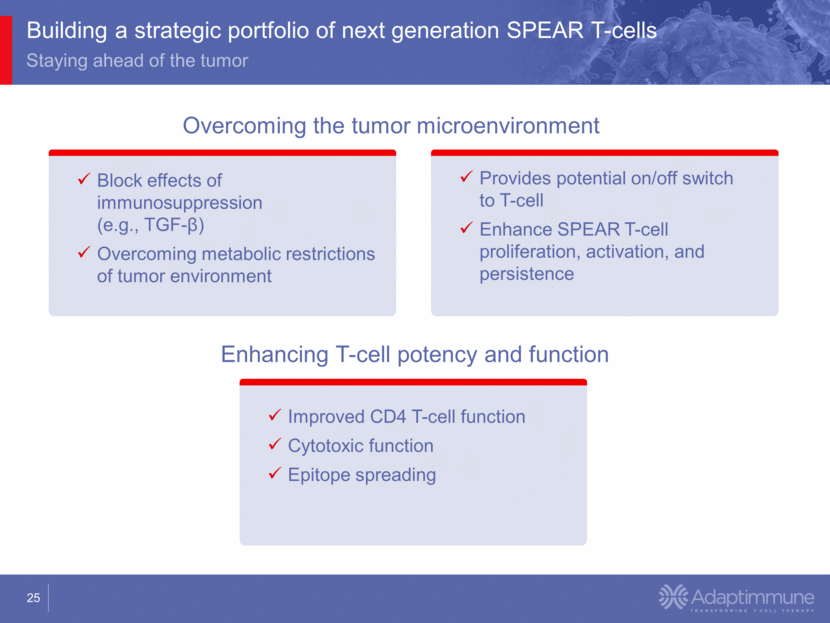
Progress to an off-the-shelf, allogeneic SPEAR T-cell 26 Important milestones in our collaboration with Universal Cells GMP stem cell line Select clones Gene edit cells Universal donor cell with SPEAR Sequence and screen Differentiate into mature T-cells Multiple off-the-shelf patient doses Iterative, rAAV-based gene editing to: Remove HLA Class I, II, TCR Add HLA-E, affinity optimized TCR

Global technology network: partnering with industry leaders 27 Building the future of T-cell therapy through world-class expertise Clinical Platform development Manufacturing (HCAT)
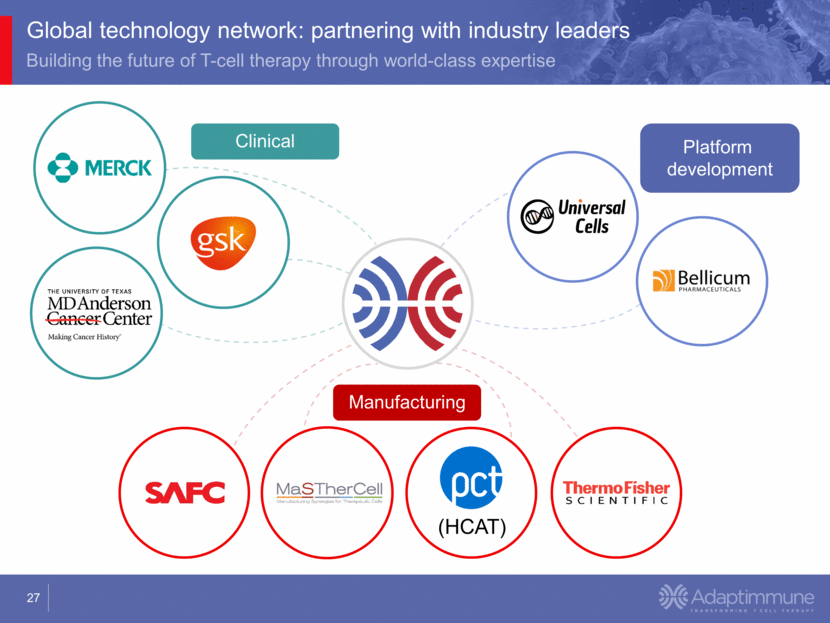
Adaptimmune SPEAR T-cell studies at leading clinical centers 28 Building the future of T-cell therapy through world-class expertise Palo Alto UCLA

Solid financial position

Strong balance sheet: Runway to 2020 30 Enables delivery of data from MAGE-A10, MAGE-A4, and AFP $232 million 2020 Through early LIQUIDITY* FUNDS current business operations *as of Nov 2, 2017 – Total liquidity is the total of cash and cash equivalents, short-term deposits, and marketable securities

31 Leaders in TCR T-cell therapy Proprietary pipeline in solid tumors with data through 2018 Strong data from partnered NY-ESO program in 2017 Scientific leadership in TCR T-cell therapy Building a fully integrated cell therapy company Solid financial position Data in 2018 from proprietary pipeline in solid tumors

Building an integrated SPEAR T-cell company January 2018 32
